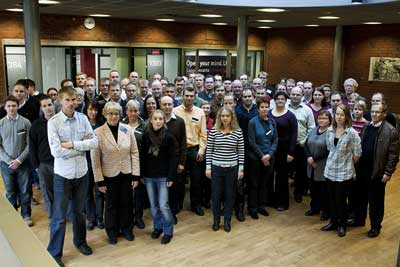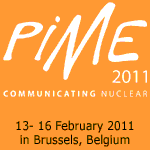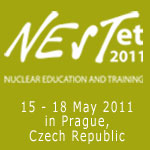
The Finnish Nuclear Society (ATS): Education and training
Eight national nuclear courses (YK) organised
The need to educate a new generation of experts in the nuclear field became an urgent priority once the Finnish Government gave a favourable decision-in-principle to TVO’s application to build Olkiluoto 3 -nuclear power plant (NPP), which the Parliament ratified on 24 May 2002. Jukka Laaksonen, Director General of the Radiation and Nuclear Safety Authority (STUK), together with its former Director, Ami Rastas, (TVO), invited public and private organisations active in the nuclear industry to take part in a kick-off meeting, in October 2002, to discuss the organisation of a national nuclear training course. At the meeting Professor Riitta Kyrki-Rajamäki from Lappeenranta University of Technology (LUT) was elected Chairwoman of the organising committee.
The first “YK” course started in October 2003 and included 6 weeks of training based on IAEA safety course material, which was adapted to suit the Finnish context and needs. Since then, the course has been organised every winter, between October and March, at a time when there are no outages at any Finnish NPPs.
The lecturers come from the participating organisations, which earn seats on the course based on their contribution to the course’s organisation. Over the years, LUT has managed the course. The 8th YK course is now under way and to date almost 500 people have participated. The focus of the lectures has changed over time to take more account of new build. The course has also been shortened to 21 days, organised within 6 time periods, partially in response to course evaluation and feedback from participants.

Participants in the 8th YK course at Lappeenranta University of Technology (photo by Timo Mikkola, LUT).
First national pilot course on nuclear waste management
Different nuclear waste management operators in Finland have traditionally educated and trained their experts' themselves. Therefore, the need for a more national training course in this area was clear. In 2008, Jaana Avolahti, from the Ministry of Employment and Economy (MEE), together with Kaisa-Leena Hutri from Radiation and Nuclear Safety Authority (STUK) and Marjatta Palmu, from the waste management company Posiva Oy, created a national training course for post-graduat students and young engineers. It was part of the Finnish research programme on nuclear waste management (KYT) (For more information, visit: www.ydinjatetutkimus.fi).
Professor Jussi Leveinen and Mira Markovaara-Koivisto, from Aalto University, joined the team and the first pilot course took place at Aalto University, in Espoo, in December 2010. It focused on four main topics: the nuclear fuel cycle and radioactive waste, the principles of waste management, the management of operational and decommissioning waste and the final disposal of spent fuel. Technical visits to research laboratories dedicated to nuclear waste management and to the research reactor (FIR) at the Technical Research Centre of Finland (VTT), at Otaniemi (in Espoo) were also included in the course. The lecturers and 20 participants in the pilot course came from Finnish public and private organisations working in waste management. The first course was two and a half days’ long, but it will be expanded to 5 days in 2011. (Source: an article by Mira Markovaara-Koivisto et al, will be published in the ATS’ Ydintekniikka magazine, N:o 1/2011
(www.ats-fns.fi/eng/quarterly/editorial.html ).

Participants visited VTT's FIR research reactor, in Otaniemi.
Transferring knowledge from "the old to the young generation"
In November 2010, in Säätytalo, Helsinki, ATS Seniors and ATS Young Generation organised a joint seminar on the topic of atomic power in Finland. The purpose of the seminar was to highlight the history and development of nuclear power in Finland in the 1960's and 1970's. It also aimed to help transfer knowledge from the older to the younger generation. This is especially important when you consider that an increasing number of the experts in Finland have retired or will be retiring soon. About 80 senior experts and YG engineers participated in this one-day seminar. The programme covered the first steps that were taken in Finland, mostly in 1960's and 1970's, to prepare for country's first NPPs. These steps included doing the groundwork to provide for the education of nuclear engineers, early nuclear energy legislation and creation of an independent nuclear safety authority. Other presentations included Finnish industry's contribution to the first NPPs in Finland and the current situation with regards to education, research, and regulatory guidelines in Finland.
The seminar started with a presentation by Academy member and ex-Director General of VTT, Pekka Jauho. He spoke about the very first days of atomic power in Finland, leading eventually to the construction of the subcritical pile and TRIGA Mark II research reactor (FIR1), in Otaniemi (Espo). Seppo Salmenhaara continued the story of the FIR1 research reactor, describing its purchasing and the first years of its operation. Jorma Aurela, from the Ministry of Employment and Economy (MEE), described the status of nuclear education and research in Finland today. Juhani Santaholma (ex-President of Finenergy), Antti Vuorinen (ex-Director General of STUK) and Pekka Salminen (STUK) gave an overview of the development of nuclear law and other related legislation, and spoke about important international agreements and of the start-up of regulatory and supervisory activities. Tapani Graae continued with a presentation about the achievements of the Finnish industry in the 1960's and 1970's with the construction of components and systems for nuclear power plants.
The seminar ended with a panel discussion with senior and young participants about efficient knowledge transfer and the future of nuclear power. All the presentations are available on the ATS web-site, in Finnish (www.ats-fns.fi/info/arkisto.html).
|






